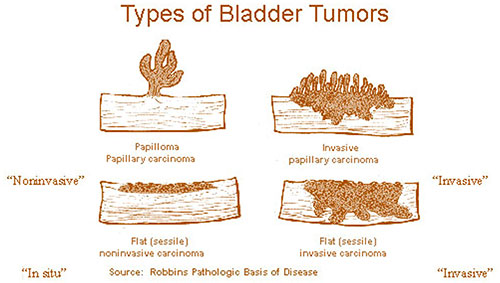Behavior
Distinguishing Noninvasive and Invasive Bladder Cancer
The two main types of bladder cancer are the flat (sessile) variety and the papillary type.
Only the flat (sessile) variety is called in situ when tumor has not penetrated the basement membrane.
A papillary tumor that has not penetrated the basement membrane is called non-invasive, and pathologists use many different descriptive terms for noninvasive papillary transitional cell carcinoma.
Frequently, the pathology report does not contain a definite statement of non-invasion; however, non-invasion can be inferred from the microscopic description. The more commonly used descriptions for non-invasion are listed below. All are coded as in situ.

Types of Bladder Tumors.
Definite Statements of Non-invasion
- Non-infiltrating
- Non-invasive
- No evidence of invasion
- No extension into lamina propria
- No stromal invasion
- No extension into underlying supporting tissue
- Negative lamina propria and superficial muscle
- Negative muscle and (subepithelial) connective tissue
- No infiltrative behavior/component
- Tumor that has not penetrated the basement membrane
- No infiltrative behavior/component
- Unknown status of submucosa (unknown whether invasive or in-situ)
Note: These descriptions of non-invasion apply to bladder cases only.
Inferred Description of Non-invasion
- No involvement of muscularis propria and no mention of subepithelium/submucosa
- No statement of invasion (microscopic description present)
- (Underlying) Tissue insufficient to judge depth of invasion
- No invasion of bladder wall
- No involvement of muscularis propria
- Benign deeper tissue
- Microscopic description problematic for pathologist (non-invasion versus superficial invasion)
- No mural infiltration
- No evidence of invasion (no sampled stroma)
Code the behavior as malignant /3, not in situ /2, when
- the only surgery performed is a transurethral resection of the bladder (TURB) documenting that depth of invasion cannot be measured because there is no muscle in the specimen
- AND the physician’s TNM designation is not available
Code the behavior as in situ /2 when the TNM designation is Ta for TURB with no muscle in the specimen.
Note: Behavior cannot be determined by cytology
Updated: April 22, 2025
Suggested Citation
SEER Training Modules: Behavior. U.S. National Institutes of Health, National Cancer Institute. Cited 30 December 2025. Available from: https://training.seer.cancer.gov.




